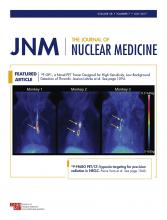TO THE EDITOR: A recent article by Moghbel et al. (1) concluded that the available data largely support the indispensable role that 18F-FDG PET/CT imaging has come to play across the many stages of treatment and subtypes of disease encompassed by lymphoma. However, and unfortunately, several important facts that shed a different light on the role of 18F-FDG PET/CT in the response assessment of lymphoma were not mentioned in their article.
The first of these facts is the spatial resolution of PET. Whole-body PET images have a typical spatial resolution of 6–9 mm. Residual lymphoma deposits with a size well below this spatial resolution are missed by PET. This is exemplified by several findings. First, 18F-FDG PET/CT is commonly negative, whereas concomitant bone marrow biopsy (which assesses the bone marrow at a microscopic level) is positive (2). Second, a relatively high proportion of patients with curable lymphoma histologies who are treated with curative intent develops disease relapse during follow-up (3,4), which underlines that acquiring an 18F-FDG PET/CT–negative status is not synonymous to cure. Third, lymphoma patients receiving palliative chemotherapy not infrequently have a negative 18F-FDG PET/CT scan, although this merely means that the macroscopic tumor bulk has disappeared but that microscopic disease is still present. Similarly, patients with indolent, incurable 18F-FDG–avid lymphomas who are treated with noncurative chemotherapy not infrequently acquire an 18F-FDG PET/CT–negative status. Fourth, additional radiation therapy in chemotherapy-treated patients with a negative end-of-treatment 18F-FDG PET/CT scan has been shown to significantly reduce relapse rates (5), again indicating that 18F-FDG PET/CT can never exclude residual disease.
Another important fact not mentioned in the article of Moghbel et al. is the nonspecificity of 18F-FDG. A recent metaanalysis showed that the majority (55.7%) of lesions that are 18F-FDG–avid during and after therapy for lymphoma prove to be false-positive on biopsy because of inflammatory changes (6). Remarkably, histopathologic data on the nature of 18F-FDG–avid lesions on interim PET in Hodgkin lymphoma are still completely lacking (6).
A third fact not mentioned is the poor methodology of observational interim and end-of-treatment 18F-FDG PET/CT studies. The areas under the summary receiver-operating-characteristic curve were reported to be 0.877 for interim 18F-FDG PET/CT in predicting treatment failure in Hodgkin lymphoma, and 0.651 and 0.817 for 18F-FDG PET/CT in predicting treatment failure and death in diffuse large B-cell lymphoma, by two recent metaanalyses (7,8). However, the studies on this subject suffered from numerous methodologic flaws. One important methodologic concern in these studies is that they used only follow-up 18F-FDG PET/CT (instead of histopathologic confirmation) as the reference standard for treatment failure (7,8) However, false-positive posttreatment 18F-FDG PET/CT results are common (6). As a result, the value of 18F-FDG PET/CT in predicting treatment failure is probably considerably overestimated. The same applies to death, since positive 18F-FDG PET/CT results without histopathologic confirmation may (incorrectly) initiate additional intensive therapies, with associated morbidity and mortality. With regard to the predictive value of end-of-treatment 18F-FDG PET/CT, Moghbel et al. referred to older metaanalyses by Zijlstra et al. (9) and Terasawa et al. (10) and mention this test to be reliably prognostic. However, Moghbel et al. failed to mention that the studies these metaanalyses included also used follow-up 18F-FDG PET or PET/CT as the reference standard, thus introducing the same serious bias. Of note, although the value of end-of-treatment 18F-FDG PET/CT is considerably overestimated (3,4,6), it is widely used in clinical practice for treatment decisions, often without histopathologic confirmation.
Finally, the article does not mention the lack of a control arm in interim 18F-FDG PET/CT–adapted trials. Given the poor methodology of the observational studies on interim and end-of-treatment 18F-FDG PET/CT (which is, unfortunately, widely ignored), there is actually no sound scientific basis on which to perform interim 18F-FDG PET/CT–adapted trials. Importantly, all interim 18F-FDG PET/CT–adapted trials that have been performed so far (1) also suffer from a major flaw, namely the lack of a control arm. If escalated therapy is applied to only (a subgroup of) interim 18F-FDG PET/CT–positive patients (and all interim 18F-FDG PET/CT–negative patients receive standard therapy), any improvement in outcome in the former group may simply be due to the greater effectiveness of intensified therapy rather than being the merit of 18F-FDG PET/CT–based patient selection. Similarly, if deescalated therapy is applied to only (a subgroup of) interim 18F-FDG PET/CT–negative patients (and all interim 18F-FDG PET/CT–positive patients receive standard therapy), any claim of noninferiority of this strategy compared with standard therapy in all patients with regard to outcome may simply be due to the generally good outcome of the entire population rather than being the merit of an 18F-FDG PET/CT–based patient selection.
Given the aforementioned facts, it is our opinion that interim and end-of-treatment 18F-FDG PET/CT has too quickly entered the clinical arena, without consideration of its intrinsic limitations and without a solid foundation of evidence.
Footnotes
Published online Jan. 6, 2017.
- © 2017 by the Society of Nuclear Medicine and Molecular Imaging.







